Colors
PetPom

The
Pomeranian
Information
Center
Pomeranian Colors
Overview
Let's talk about the colors of a Pom's coat.Those who are not familiar with this breed often associate orange as the color of the Pom.
However, while it is indeed considered to be a 'classic' color, it is not an overstatement to say that this adorable toy breed comes in a rainbow of various coats.
It is truly remarkable how the Pomeranian originated from a pure white sled dog (weighing over 30 pounds) into one of the dogs with the most interesting possibilities in appearance.
There are solids, partis (two colors), tri-coats, and even more... as a speckled merle will hold 5 or even 6 different hues.
Let's talk about the colors of a Pom's coat.Those who are not familiar with this breed often associate orange as the color of the Pom. However, while it is indeed considered to be a 'classic' color, it is not an overstatement to say that this adorable toy breed comes in a rainbow of various coats.
It is truly remarkable how the Pomeranian originated from a pure white sled dog (weighing over 30 pounds) into one of the dogs with the most interesting possibilities in appearance.
There are solids, partis (two colors), tri-coats, and even more... as a speckled merle will hold 5 or even 6 different hues.
List of Pomeranian Colors
Sable -
Sometimes this color will not show in a
Pomeranian picture, if the sabling is very light. Yet with other Poms, it's distinct. A sable Pomeranian will have a solid base and the sable comes into play via guard hairs that have dark tips.
There are many types of sables, including cream sable (light base coat with black guard hairs) color code S 348, chocolate sable (brown coat with black guard hairs) color code A 350 and just about everything in-between.
Red -
A red Pomeranian
will be a reddish-orange colored dog that is often described as a rust color. It will be the darkest, deepest orange possible in regard to fur. This color is rather rare, and it is not uncommon for a dark orange to be incorrectly categorized as a red, color code S 140.
Orange -
An orange Pomeranian, color code S 133 can range from light to dark. There is a find line between dark orange and red. If any black striping occurs, this brings it to a orange brindle. Any black tipping brings it to an orange sable, color code S 137.
Cream -
With a cream Pomeranian, color code S 076, color can actually range quite a bit. This can be very light - one step darker than a white, and it goes through shade gradients all the way to what one would consider to be light brown.
How do you distinguish a dark cream from chocolate (brown)? It will show in the skin pigmentation of the Pom. A deep cream Pom will have black pigmentation, and a chocolate will have brown points (eye rims, nose, lips, paw pads).
Buyer beware - creams are often born white.
They will then have a darkening of hairs as they mature, most often done during the 'puppy ugly' stage.
Black -
Black Pomeranians, color code S 007, will have deep, solid black eye rims, nose, lips and paws. A true solid black will not have a secondary color. If any exists, the dog will be a parti. Small patches can be dubbed 'markings', larger patches 1/3 of the coat or more, will put the Pom into the category of black (color code S 007) with white markings (s 014), black and tan (S 018), etc.
Blue -
A blue Pomeranian is a less commonly seen, yet is a beautiful color. The easiest way to spot a blue color code S 037, is by looking at the nose. All true blue Poms will have blue skin; this is what sets them apart from black coats; with blue, the coat may appear black but if the skin pigmentation is blue, the Pom will genetically be a blue.
Blue is a diluted black. Sometimes the fur will look dull; with other dogs it may have a metallic tinge to it. The skin points (nose, eye rims, paws, lips) will have a blue tint (sometimes only noticeable in bright sunlight)... Blue eyes are more common in blue Pomeranians and merles.
They will then have a darkening of hairs as they mature, most often done during the "puppy uglies" stage.
Black -
Black Pomeranians, color code S 007, will have deep, solid black eye rims, nose, lips and paws. A true solid black will not have a secondary color. If any exists, the dog will be a parti. Small patches can be dubbed 'markings', larger patches 1/3 of the coat or more, will put the Pom into the category of black (color code S 007) with white markings (s 014), black and tan (S 018), etc.
Blue -
A blue Pomeranian is a less commonly seen, yet is a beautiful color. The easiest way to spot a blue color code S 037, is by looking at the nose. All true blue Poms will have blue skin; this is what sets them apart from black coats; with blue, the coat may appear black but if the skin pigmentation is blue, the Pom will genetically be a blue.
Blue is a diluted black. Sometimes the fur will look dull; with other dogs it may have a metallic tinge to it. The skin points (nose, eye rims, paws, lips) will have a blue tint (sometimes only noticeable in bright sunlight)... Blue eyes are more common in blue Pomeranians and merles.
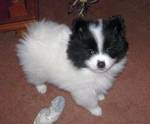
Adorable white Pomeranian with black markings. The white running over the forehead is called a flare. Meka, owners: Tony & Lola Brown

Beautiful red sable Pomeranian- notice how the deep rich coat has black tipped hairs.
Sasha, Owner: Tan Jia Yi
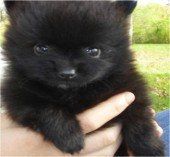
Amazing solid black Pomeranian. To have a solid coat without any other coloring is rare.
Raphie, Owners: Seth & Katie
-174x243.dm.edit_AbjCYB-388w.jpg)
-174x243.dm.edit_AbjCYB-400w.jpg)
A rare, pure solid white Pomeranian
Photo courtesy of Diamond Ice Poms
White -
A true white, color code S 199, will be a pure snow, there will not be any shading to the coat, otherwise this places the dog into the cream category.
The color will be solid without another hue mixed in. A secondary color will move the Pomeranian to a parti (2 colors).
Some parti's are solid at birth and the secondary color will grow in as the Pom matures. For this reason, some Poms are registered as whites, but will mature into parti's. More on
White Pomeranians
Wolf sable -
Such a wonderful coat...This is a light grey undercoat with a darker shade of steel grey guard hairs with black tips, color code S 230. There will not be cream or an orange tint to the grey base color. With a wolf sable Pomeranian, eye rims, nose, lips and pads are black.
Photo top right: A rare, pure solid white Pomeranian, Photo courtesy of Diamond Ice Poms
Chocolate - Many, but not all, chocolates will remind you of a Hershey's chocolate bar. More often than not, it is a deep, dark, thick brunette. However, any hue as light as what may appear to be a cream is considered a chocolate, S 071, as long as skin pigmentation is dark brown (beaver has a lighter noise).
You can read more here: Chocolate Pomeranians
Brindle -
This is actually a pattern of color and is categorized as a marking (S 071). With this, there will be a base undercoat of a light color (tan, orange, etc.) and then there will be stripes running over that color. The stripes can run thin or thick. With some, this brindling will only be apparent on the saddle (back).
-250x179.dm.edit_mqmMbO-345w.jpg)
-250x179.dm.edit_mqmMbO-560w.jpg)
This is a true chocolate colored Pom. Notice how the nose is brown.
Kooter, Owner: Kelly Brown
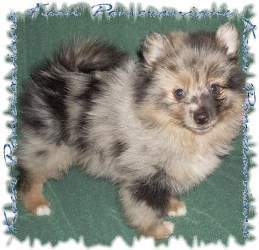
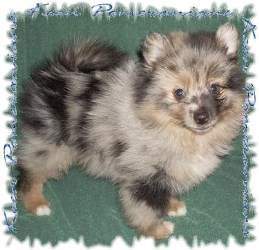
Wonderfully specked merle Pomeranian. Notice how the color is splashed over the coat.
Photo courtesy of Keen Pomeranians
Merle - The merle gene creates a splattering effect of color on the coat. This color is accepted by the AKC as a standard color; however, other countries do not allow for merles.
Most often you will see a light blue, grey, black, tans, or reds blended in, usually in patches or 'dots', giving the dog an interesting speckled appearance. More on the Merle.
Lavender -
This is an exotic Pomeranian color, is very rare, and is not an accepted color. Sometimes it is referred to as lilac.
These Poms will have a sheen to the coat that appears to be light purple.
Lavender Pomeranians must be registered under a different color. Depending on the hue of the coat, the color code used may be a cream or a beaver.
There is some debate regarding how lavender is produced. Lavender can be the result of a diluted Blue (most commonly accepted theory) or a diluted Beaver (also very possible).
As with all Pomeranians, this color can be solid or parti (seen with a secondary color). A lavender parti could be seen with white, or with tan.
Beaver -
Beaver is an interesting color. Pomeranians that are beaver are so based on their skin pigmentation. The actual color of the coat will be somewhere in the brown range; this can be as light as a cream or as dark as a chocolate.
The nose, eye rims, lips, and paw pads will be a beaver color (see photo right; below on mobile).
Parti Colored Pomeranians
Any Pomeranian that has more than just a small patch of white (which could be classified as a marking, i.e. black with white marking) will be designated as a parti (two colors in the coat, and the AKC prefers that one of the colors is white).
Parti Poms are very popular, as each dog will be unique and the patterns can be quite remarkable.
Some dog breeds deducted points if the colors do not fall 'right'.
-min-269x300-510w.jpg)
(continued below)
-min-269x300-400w.jpg)
Chip, a beautiful beaver colored Pomeranian puppy.
Photo courtesy of Eileen Andrews
-min-251x335-520w.jpg)
-min-251x335-554w.jpg)
Finnley, at just 5 weeks old
Photo courtesy of Stacy V.
However, a Pomeranian of any combination holds the same value as a solid Pom. This said, we should note that some dog organizations will give higher points to a parti-pom if:
* The Pom has a base coat of white with only 1 certain secondary color
* The patches are symmetrical. For example, a white Pomeranian with a black patch on each leg
* There is a strike of white running up the head
* The patch matches the points. The points are the lips, eye rims, nose and pads of the paws. Any patches that fall in the blue category should have corresponding blue points. A Pom with brown patches should have brown points and a Pomeranian with just about every other colored fur patches would have black points.
The genes that create parti Pomeranians can skip generations. But, when 2 parti Pomeranians are breed together, this will always produce parti puppies.
There are 3 basic types of
Parti Pomeranians: Irish Parti, Piebald Parti and Extreme:
- What is an Irish Parti? This dog will have a white collar, chest, legs and most often blaze.
- What is Piebald Parti? This type will have 50/50 coloring.
- What is a Extreme Parti? This dog will have 80% or more of white fur and will have spots of other color on its back.
Color Changes
Color changes due to natural processes:
Can a Pomeranian change colors? Yes! And it happens more often than not. In fact, when you bring your new Pom puppy home, do not completely fall in love with his color, because it will be changing; the only question is to what degree.
Starting around the 4 to 6 month mark, Pomeranians enter a phase referred to as the puppy uglies. During this time, the soft one-layer puppy coat falls out. It is replaced by the two-layered adult coat. And when this happens, there will be noticeable differences.
All sorts of color changes can happen:
- Small patches of color can turn into the Pom's most prominent color.
- The entire coat can darken (a light chocolate and turn into a dark chocolate, etc.)
- The whole coat can lighten (a red can fade into an orange, etc.)
- Sabling (dark tipped hairs) or brindling (stripes) can just about completely disappear or come in much heavier.
This color change ends when the transition to adult coat ends, which is anywhere from the 10 to 15 month mark. At that time, you will know your Pomeranian's true color.
For this reason, it is not unusual for Pomeranians to be registered as a color that they do not hold as adult dogs.
Color changes due to the sun:
If the coat is exposed to too much sunlight, this can cause a Pomeranian's coat to become burnish (browns can develop red tints) or to fade, no matter what his color. In addition, you may notice a drying to the hair, and it may feel brittle to the touch.
As part of your grooming methods for your Pom,it is recommended to use a quality leave-in conditioner with a sunscreen in it like Chris Christensen Ice on Ice Conditioner with Sunscreen
 to protect the coat not only from the sun, but from contact friction, other elements which can cause split ends, and to help prevent tangles.
to protect the coat not only from the sun, but from contact friction, other elements which can cause split ends, and to help prevent tangles.
Example of a color change:
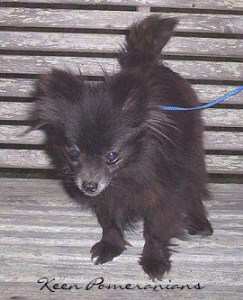
This Pom is 6-months-old in this photo. His coat looks very thin because he is in the puppy ugly phase of losing his puppy fur. Notice that on his upper front leg is a small patch of brown.

This is the same Pomeranian, but now at 11-months old. That small brown color is now his main coat color. While not all Poms will change this much, this sort of occurrence is certainly not uncommon.
Example of dramatic color change:
As mentioned, coat color changes are expected. However, sometimes, the change can be more than you could have imagined. Have a look at little Dudley (below). The first photo was from May of 2015. The second was more recent, after a ring of pure white hair grew in to frame his face.
This amazing color change is due to the graying gene (G). Despite the name, the graying gene can cause hairs to turn white. Quite a few breeds can have this gene, including the Pomeranian. This gene causes graying as a dog matures (the dog is not born with the lighter color); it can begin to happen at any time, at any rate of speed, and is not related to graying that occurs with some dogs in old age.
Essentially, the graying gene causes some hairs to not hold color as they otherwise would.
And the reason that the white appears as a circle is that this Pom genetically has a black mask, which keeps the face black.
Before
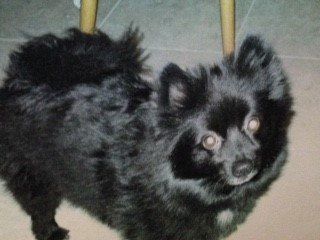
After
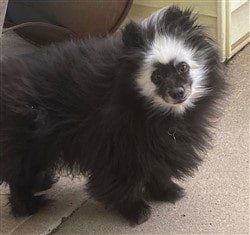
Before

After

Photos courtesy of Elaine Berg
Please note that Dudley passed away on his 14th birthday, on Valentine's Day 2020. RIP sweet Dudley.
Does Coat Color Matter?
In the show ring, solids are not preferable to parti's or vice-versa. Reds are not preferable over orange.
As long as a Pomeranian is an accepted color, the playing field is even.
Merle, however, is
an exception; most major kennel clubs around the globe do not have merle as an accepted color. The AKC does, but finds blue eyes to be a flaw, and most merles have blue eyes.
If you are buying a Pom and want a certain colored dog, it is suggested to find a
reputable breeder ahead of time. Once doing so, you can ask that breeder if she has plans to breed white Pomeranians, black Pomeranians, etc. Some concentrate on certain coat colors, and this limits the chances of surprises.
Because Pomeranians are known for having color changes, the best indication of what color a Pom will end up being is to look to both parents. This said, this is not a guarantee because color and markings can skip a generation (or even two or three).
Eye and Nose Color
Eye Color
- The AKC, CKC, FCI and KC call out for a Pom to have dark eyes. But what does that mean and is it possible for a Pom to have blue eyes? Or what about green? Find out more: Pomeranian Eye Color.
Noses:
Pomeranians, per the AKC standard, should have black noses, unless self colored, as with beaver, chocolate and blue. The Pomeranian Nose Color page
covers black, blue, chocolate and lavender.
And for more, look to Beaver, Parti and Dudley noses.
Tons of Photos & Much More Information
The colors of a Pomeranian is a very complex topic. This, of course is an overview. Do you know the terms used for each part of a Pom's body that color appears on? Or how to determine what color your Pom is?
Would you like to see:
- Photos of every color in the 19 AKC list of Pomeranian colors
- Photos of colors that you do not see on the AKC list of colors, but breeders do have on their AKC applications
- Photos of every single type of marking a Pom can have
- Photos of every place a color can fall on a Pomeranian
- Photos of the different eye colors of a Pomeranian
- Detailed and easy to understand explanation of coloring, pigmentation & why certain colors exist
If so, check out the most comprehensive Pomeranian-specific book that exists NOW IN PRINT TOO!: The PetPom Book.
If you email photos to us, you agree that PetPom is given free copyright to use at our discretion. We will always credit the photo to the name of the Pom's owner(s) if it is supplied.
Email: Contact@PetPom.com
All text, images and artwork protected by US and International copyright laws. All rights reserved. Copyright PetPom.com
We are a participant in the Amazon Services LLC Associates Program, an affiliate advertising program designed to provide a means for us to earn fees by linking to Amazon.com and affiliated sites.

